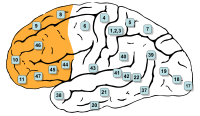
Photo from wikipedia
Drug‐induced Pavlovian memories are thought to be crucial for drug addiction because they guide behaviour towards environments with drug availability. Drug‐related memory depends on persistent changes in dopamine‐glutamate interactions in… Click to show full abstract
Drug‐induced Pavlovian memories are thought to be crucial for drug addiction because they guide behaviour towards environments with drug availability. Drug‐related memory depends on persistent changes in dopamine‐glutamate interactions in the medial prefrontal cortex (mPFC), basolateral amygdala, nucleus accumbens core and hippocampus. Recent evidence from our laboratory indicated that the cerebellum is also a relevant node for drug‐cue associations. In the present study, we tested the role that specific regions of the cerebellum and mPFC play in the acquisition of cocaine‐induced preference conditioning. Quinolinic acid was used to manage a permanent deactivation of lobule VIII in the vermis prior to conditioning. Additionally, lidocaine was infused into the prelimbic and infralimbic (IL) cortices for reversible deactivation before every training session. The present findings show, for the first time, that the cerebellum and mPFC might act together in order to acquire drug‐cue Pavlovian associations. Either a dorsal lesion in lobule VIII or an IL deactivation encouraged cocaine‐induced preference conditioning. Moreover, simultaneous IL‐cerebellar deactivation prevented the effect of either of the separate deactivations. Therefore, similar to the IL cortex, neural activity in the cerebellum may be crucial for ensuring inhibitory control of the expression of cocaine‐related memories.
Journal Title: European Journal of Neuroscience
Year Published: 2018
Link to full text (if available)
Share on Social Media: Sign Up to like & get
recommendations!